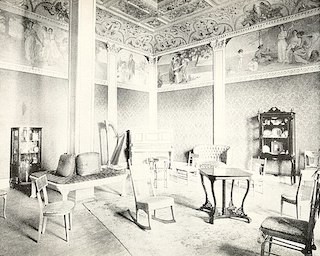Alice B. Muzzey, 1865 – 1943
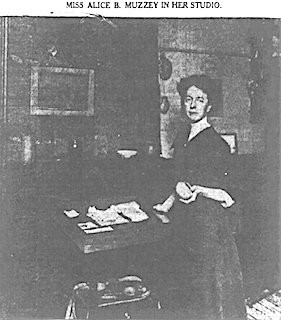
Alice B. Muzzey (sometimes identified as Mussey) was born August 9, 1865 in Cambridge, Massachusetts to Ellen Emerson and Henry W. Muzzey, prominent attorney who had graduated from Harvard Law School. She had an older brother and sister. A pupil of the Boston Museum of Fine Arts, Muzzey was best known as a painter/illustrator, teacher, designer/decorator (furniture, basketry, textile). Her landscapes, cityscapes, portraits, and floral still-lifes were executed in oil, pastel, or watercolor. She also contributed to art and travel periodicals, notably: The Sketchbook (Chicago), The Modern Priscilla (Boston), Suburban Life, and the Home Needlework Magazine, The School Arts Book (Massachusets).
Sometime after her father’s sudden death in 1886, she moved to Buffalo, New York, where she would live and work for greater part of her life.
For the World’s Columbian Exposition of 1893, she was commissioned to oversee the decoration of the Illinois State building library. Reflecting an early Renaissance style, the room was designed in warm russet-yellow hues. For the frieze and ceiling, Muzzey designed adaptations of the book plates of William Caxton and other early printers. The Chicago Tribune qualified the frieze as “one of the most elaborate that will ornament any building on the exposition grounds” (Apr 16, 1893, p. 25). She also designed the rug, which was hand woven by Mrs. Eva J. Hamilton. Her aquarelle, “The Fisherman’s Hut” was exhibited in the Art Palace of the Exposition. A small description of the reception room and library was written in the Catalogue of the Woman’s Exposition Board:
The woman's reception room and library were an object lesson in decorative art, although fine arts and practical arts paid their full quota toward its beauty and comfort. Competitive designs for the decoration of these rooms were submitted, and that of Miss Ida J. Burgess was chosen and she was made director of decoration. She appointed Miss Alice B. Muzzey decorator of the library. The chief decorative feature of the reception room was the frieze already mentioned, which was designed and painted under the direction of Miss Burgess. Much original designing, modeling, carving, and weaving, were shown in the ceiling and cove, silk window hangings, stained glass of the windows, carved wood transoms of the doors, carved mantel with its hand painted tiles, carved furniture, embroidered cushions and varied bric-a-brac. The color scheme of the reception room was white, green and gold; of the library, warm yellow. For the ceiling and frieze of the latter room. Miss Muzzey made a design adapted from the book plates of William Caxton and other early printers, the whole room being in the early renaissance style (20-21).
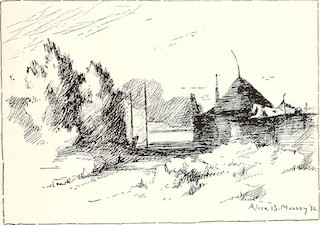
On October 1, 1896, Muzzey opened the first studio at the newly built private woman’s club, the Twentieth Century Club – founded by Charlotte Mulligan, a music teacher and music editor at the Buffalo Courier Express, to advance the interests of education, literature, and art. Here, Muzzey was joined by her artist friend Clara E. Sackett (portraits landscapes, miniatures) who had just returned from a 5-year sojourn in Paris. They taught classes in design and the history of art and architecture. After a summer of plein-air painting in Canada in 1899, Alice sailed for Paris in early October 1900, traveling in Europe through April 1901. According to the Buffalo Morning Express, Alice stayed at the Girls’ Club, working at the Académie Colarossi; she exhibited the work she accomplished in Paris in her Buffalo studio, including a sketch of the courtyard of the Girls' Club (November 13, 1902, p. 9). The same article mentions that she participated in the annual March 1901 AWAA exhibition, with a painting of the Luxembourg gardens – a work admired by Mary Fairchild MacMonnies, organizer of the exhibit.
When she returned to Buffalo, she established a studio on Virginia Place, which the Buffalo Evening News described as a delightful potpourri of styles and colors:
[…] the walls are hung with Aztec hats, baskets and buttons, old French tapestries and other paraphernalia dear to an artist’s heart, and, more important than all, the collection of paintings which represent Miss Muzzey’s work in Paris last year. In this, portraiture has a very large part, and Miss Muzzey has received many congratulations from her friends and much encouragement for what she has done. Her models have been peasants, men, women and children, and the Paris studio models, and many things [that] appeal at once to the liking and sympathies. You feel you would like, yourself, to have a word with Miss Muzzey’s models (November 22, 1901, p. 3).
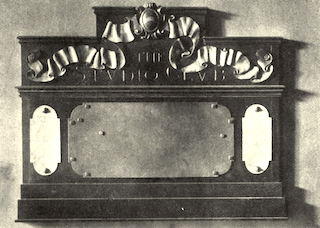
Here, and in her successive studios at 50 Allen, 391 and 516 Franklin streets, she taught painting, watercolor, and drawing to young people for whom she staged yearly exhibits. Her classes were very popular and her various studios gathered numerous artists, art-lovers, and local socialites who attended her regular teas and exhibitions. Muzzey was also a fervent promoter of handicrafts or “hand-wrought articles.” In an article for the December 1906 Sketchbook, she decried the fact that:
[…] even though repeated efforts have been made to organize an Arts and Crafts Society, there has never been sufficient encouragement for one. Although the Buffalo Society of Artists came into being some fifteen years ago and has more or less flourished as an association of painters and sculptors ever since, no attempt was made to incorporate with it the applied arts until six months ago. It is true that under its auspices the Arts and Crafts Exhibition was given in the spring of 1900. This was very successful both from an artistic and financial point of view, but the Arts and Crafts Society that was expected as a natural sequence failed to materialize (206).
Her efforts and those of other artists like Clara Sackett materialized in an exhibition on January 16, 1906 devoted to color prints, monotypes, and stenciled works, that included two-three dozen Japanese prints. It was followed by an exhibit of textiles, beadwork, handwoven rugs, and baskets. A third exhibit in March of that year featured work in leather, metal, and wood. Their efforts led to an alliance of handicrafts and artworks in future exhibitions held by the Society of Artist:
[…] the lesser undertaking was merged in the greater and a union of the arts was held from April 27 to May 22, in the Albright Gallery. Exhibitions for the coming year are already being arranged for, following the same general plan; the venture having fully justified its existence (210).
Alice returned to Europe from February 2 to April 12, 1907, traveling mainly to Naples and Rome in Italy, making studies for her new rice paper paintings. She was so impressed with her pilgrimage in southern Italy that she wrote a small article, “Italian Hotel Gardens,” lauding the harmonious rapport between architecture and nature in the Italian hotels where she stayed:
Love of nature is inborn in the Italian; whether due to the influence of his surroundings, to sunny skies, or to an esthetic make-up is of no consequence, the result is harmony. The proprietor of an Italian hotel does not think his duties ended when he provides his guest with a good bed and a palatable table, he does more — he gives him a view. Before his window stretches a fair prospect of gardens beautifully planned and tended, of flower-bordered walks, leading to tinkling fountains. Terraces facing sea or hills tempt him forth to stroll through pergolas to quiet corners where he may enjoy a cigar and a book far from the madding crowd. No trouble and, it would seem, no expense has been spared to make the externals as attractive and comforting as those pleasures of the inner man (21).
In 1909, she also published an article with photos in The Travel Magazine detailing her hastily-planned, but very rewarding, eleven day-peregrinations through Sicily with four other women.
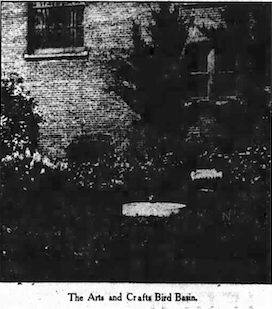
On her return to Buffalo, she expanded her studio at 516 Franklin Street to include not only indoor crafts but also outdoor furnishings displayed on her veranda and in her carefully curated garden: rugs, hangings, bird basins, seats, pedestals, and flower pots. By 1912, the studio had become a store that where one could buy rugs imported from India, leatherworks, traditional woodcarvings, and her own basketry.
Her interest in foreign and local crafts did not prevent her from painting. She continued to show her portraits and scenes from France and Italy in oil, watercolors, or pastels in local group exhibits (notably the Buffalo Society of Artists exhibitions held at the Albright gallery). She also created graphic designs for needlework, rugs, silk hangings, and posters. In 1913, she designed the tag and seal for the Buffalo Association of the Blind – a lighthouse with two searchlights.
Besides the Buffalo Society of Artists, she was an exhibiting member of the Buffalo Fine Arts Academy, the Art Students’ League of Buffalo, Arts Club of Buffalo, the Artist and Illustrator’s Club of Buffalo (Charter Member), the Association of Artists and Illustrators of Buffalo (Charter Member), as well as with the Boston Society of Arts & Crafts. Her work was exhibited in group shows that included Clara Sackett, Claire Shuttleworth, Anna Wing, Eugenie Hauenstein, among many others.
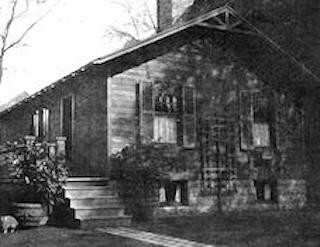
According to The Buffalo Times, in early 1915 she leased the land owned by the Buffalo Academy of Medicine and installed a portable 3-bedroom California redwood house she had ordered from a catalog (January 18, 1915, p. 7). She wrote an article about the house, “The Brushwood Bungalow, where she lived and worked, exhibiting her own works as well as foreign and domestic crafts. Muzzey moved once again to another studio but little has surfaced on her activities after 1924, when her brother who lived behind her studio died of pneumonia.
Mark Strong of Meibohm Fine Arts, Inc. compiled a chronology of Alice Muzzey’s life, which provides a bit more information on her ultimate destiny:
Alice never married. It appears she was at the Gowanda State Homeopathic Hospital for the Insane by 1925, which was shortly after her brother’s death in 1924. Records from Ancestry.com show she was aresident there until after 1940, presumably until her passing in 1943. She is buried in Forest Lawn Cemetery in Buffalo, NY (personal communication, 2024).
Sources
- “A Studio Tea.” Buffalo Evening News, November 22, 1901, p. 3. Newspapers.com.
- “Artists at Home” Buffalo Courier, February 6, 1902, p. 5. Newspapers.com.
- “Arts and Crafts Work of Buffalo Women.” Buffalo Evening News, December 16, 1911, p. 8. Newspapers.com.
- Barney, William J. The Art & Artists of Buffalo, January 29, 2015, Issu.
- "Birds Enjoy Muzzey Basin." The Buffalo News, June 22, 1912, p. 8. Newspapers.com.
- “By Illinois Women.” Chicago Tribune, April 16, 1893, p. 25. Newspapers.com.
- “Children’s Work in Art Classes.” The Buffalo Review, May 6, 1902, p. 5. Newspapers.com.
- “Coming and Going.” Buffalo Evening News, November 18, 1899, p. 11. Newspapers.com.
- "Death of Lawyer Muzzey." The Boston Globe, March 26, 1886, p. 1. Newspapers.com.
- “Entertainments.” The Buffalo Times, Nov 1, 1903 · Page 34. Newspapers.com.
- “Exhibition of Pastels.” The Buffalo Times, Mar 13, 1911 · Page 3. Newspapers.com.
- “Miss Alice B. Muzzey in her Studio.” Buffalo Evening News, March 16, 1912, p. 7. Newspapers.com.
- "Miss Muzzey at Work." The Buffalo News, October 5, 1912, p. 7. Newspapers.com.
- "Miss Muzzey's Garden Tea Comes in May." The Buffalo News, April 13, 1912, p. 8. Newspapers.com.
- "Miss Muzzey Getting Studio in Fine Shape." Buffalo Evening News, March 16, 1912, p. 7. Newspapers.com.
- “Miss Muzzey’s Pupils’ Works.” Buffalo Evening News, Apr 21, 1903, p. 15. Newspapers.com.
- “Miss Muzzey Shows Beautiful Rug.” Buffalo Evening News, Oct 26, 1912, p. 7. Newspapers.com.
- “Miss Muzzey’s Studio Reception.” Buffalo Evening News, Oct 29, 1903, p. 3. Newspapers.com.
- “Muzzey Garden is Shop at Present.” Buffalo Evening News, June 29, 1912, p. 7. Newspapers.com.
- “Muzzey has Novelty in Mind.” Buffalo Evening News, Feb 24, 1912, p. 7. Newspapers.com.
- Muzzey, Alice B. "Eleven Days in Sicily." Travel: The Magazine that Roams the Globe, vol. 14, 1908-09, pp. 215-219. Hathitrust.
- Muzzey, Alice B. “Hotel Gardens in Italy.” The House Beautiful, January 1908, pp. 21-22. Internet Archive.
- Muzzey, Alice B. “Some Notes on Arts and Crafts.” The Sketchbook, vol. 6, no. 4, December, 1906, pp. 203-210. Internet Archive.
- Muzzey, Alice B. “The Brushwood Bungalow,” The Craftsman, vol 30, n°6, September 1916. Internet Archive.
- Muzzey, Alice B. “The Afternoon print,” Northern Illinois University, Digital Library.
- “News and Notes of the Society Folks.” The Buffalo Enquirer, February 6, 1902, p. 3. Newspapers.com.
- “News of Local Artists and Some Others.” Buffalo Morning Express, December 10, 1900, p. 3. Newspapers.com.
- Official Catalogue of the Illinois Woman’s Exposition Board, 1893. Internet Archive.
- “Orchard Park Pottery.” Buffalo Evening News, January 6, 1912, p. 10. Newspapers.com.
- “Personal Mention.” The Buffalo Times, September 25, 1900, p. 3. Newspapers.com.
- “Personal Mention.” The Buffalo Times, August 22, 1900, p. 3. Newspapers.com.
- Report of the Illinois Woman’s Exposition Board, 1895, 48pp. Internet Archive.
- “Social Register.” The Buffalo Commercial, April 16, 1907, p. 14. Newspapers.com.
- “Society.” The Buffalo Sunday Morning News, March 9, 1902, p. 5. Newspapers.com.
- “Society.” The Buffalo Times, January 18, 1915, p. 7. Newspapers.com.
- Strong, Mark. “Alice B. Muzzey.” Meibohm Fine Arts.
- “The Notion Counter.” Buffalo Courier, September 27, 1896, p. 7. Newspapers.com.
- “The Arts Club.” Buffalo Evening News, May 6, 1911, p. 8. Newspapers.com.
- “Veranda Chat.” The Buffalo Times, August 14, 1913, p. 3. Newspapers.com.
